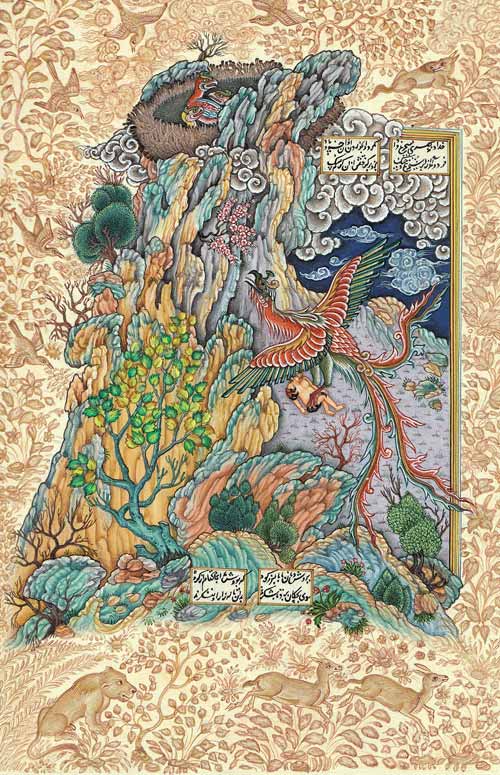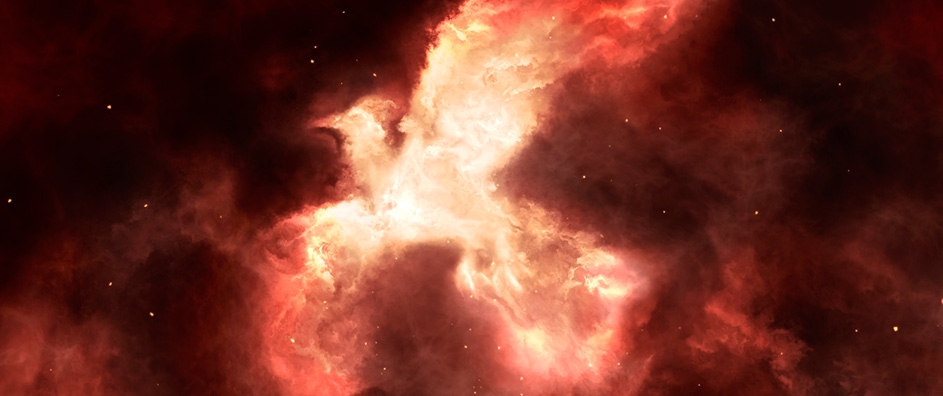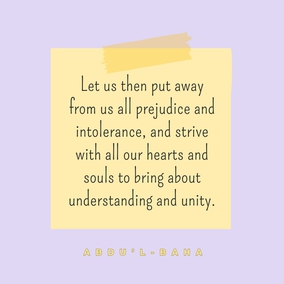The views expressed in our content reflect individual perspectives and do not represent the authoritative views of the Baha'i Faith.
The Great Being saith: … I am the royal Falcon on the arm of the Almighty. I unfold the drooping wings of every broken bird and start it on its flight.
Baha’u’llah’s writings are filled with imagery—metaphorical, mystical, and mythic. A prime example is the Phoenix. Baha’u’llah, in the passage below, refers to three mythic birds of Persian mystical literature: the Nightingale, the Hoopoe, and the Phoenix:
O YE PEOPLE THAT HAVE MINDS TO KNOW AND EARS TO HEAR!
The first call of the Beloved is this:
O mystic nightingale! Abide not but in the rose-garden of the spirit.
O messenger of the Solomon of love! Seek thou no shelter except in the Sheba of the well-beloved, and
O immortal phoenix! Dwell not save on the mount of faithfulness. Therein is thy habitation, if on the wings of thy soul thou soarest to the realm of the infinite and seekest to attain thy goal.
– Baha’u’llah, The Hidden Words (Persian Hidden Word #1), p. 22.
Here, the word for “Phoenix” is ʿAnqāʾ (Arabic, also translated as “griffin” or “gryphon”). In his celebrated lexicon, A Comprehensive Persian-English Dictionary, Francis Joseph Steingass defines this word as follows: “Long-necked; a fabulous bird, also called sīmurgẖ, said to be known as to name but unknown as to body; hence anything scarce, rare, wonderful, difficult or impossible to be got” (pp. 870–871).

Depiction of the Persian Simurgh
So let’s look at this “fabulous bird”—the Simurgh—which we can consider to be the Persian equivalent of the Phoenix of Greek mythology.
In Persian lore, the Simurgh is a mysterious bird that lives on Mount Qaf (a mythical mountain). The word “Simurgh” is a contraction of two words that translate as “the bird Saēna” in the Avesta, the Zoroastrian holy book. Originally a raptor, eagle or falcon, the Simurgh became a metaphor for the presence of God—and, more broadly, for those who seek God and who aspire to become more godly and goodly in nature.
Put another way, the “Simurgh” (when capitalized in English, since Persian has no capital letters) represents the presence of God—or the Messenger of God. In the lower case, “simurgh” represents the class of those souls who seek God. Let’s find out more about the Simurgh in one famous tale:
The Persian mystic, Farīd al-Dīn ʻAṭṭār (ca. 1142–1220), was a pharmacist and erstwhile Sufi mystic. His mystical masterpiece, The Conference of the Birds (Manṭiq al-Ṭayr), ranks among the finest exemplars of “world literature.” The tale is Persian, yet its theme is universal.
The Conference of the Birds is an allegory. Much like Aesop’s fables, the characters are animals, yet simply represent human characters.
Attar’s story begins with a colloquy of birds. (Think of birds as representing our spiritual selves.) These birds realize that they need a leader—a king—so that they can dwell together in greater peace and harmony. Among the birds is the Hoopoe, who was the ambassador sent by King Solomon to the Queen of Sheba. (In the first Persian Hidden Word, quoted above, Baha’u’llah refers to this Hoopoe: “O messenger of the Solomon of love! Seek thou no shelter except in the Sheba of the well-beloved.”) The Hoopoe tells the feathery assembly that the Simurgh, the king of birds, ought to be their king.
To seek the Simurgh, the Hoopoe persuades the other birds to undertake the arduous journey to Mount Qaf. To get there, the birds traverse seven valleys: quest, love, gnosis, contentment, unity, wonder, and poverty (selflessness). Baha’u’llah writes about these stages in the mystical quest in The Seven Valleys, acclaimed as Baha’u’llah’s most important mystical work.
Of the numerous birds that set out on their quest, only 30 birds reach their final destination. At long last, they finally behold the Simurgh. Then, before their very eyes and to their utter amazement, the Simurgh transforms itself into a mirror in which the birds behold themselves:
Lo! how great was their surprise! In the reflection of their faces these thirty birds of the earth beheld the face of the Celestial Simurg. When they cast furtive glances towards the Simurg, they perceived that the Simurg was no other than those self-same thirty birds. In utter bewilderment they lost their wits and wondered whether they were their own selves or whether they had been transformed into the Simurg. Then, to themselves they turned their eyes, and wonder of wonders, those self-same birds seemed to be one Simurg! … That one was this and this one was that. Look where they would, in whatever direction, it was only the Simurg they saw. No one has heard of such a story in the world.
— Translated by R.P. Masani, Conference of the Birds: A Sufi Allegory (Oxford University Press, 1924), p. 59.
This is not only a dramatic moment, the climax of a mystic tale with profound spiritual meaning. It is also the most famous wordplay in Persian literature. Here’s why: In Persian, the word “si” means “30.” “Murgh” means “bird.” So here’s the word play: “30 birds” (si murgh) = the Simurgh.
Abdu’l-Baha, continuing Baha’u’llah’s tradition, writes the following message to the “friends of God” and calls to mind the Phoenix, which is the Simurgh:
O ye friends of God!
They say that the origin of Caucasus (Qāfqāz) is Mount Qaf (Kūh-i Qāf). And Mount Qaf is the nest of the divine Phoenix (ʿAnqāʾ) and the celestial Simurgh. The friends of God must endeavour and display sacrifice, in such wise that this country may truly become the nest of the Simurgh of love of the Abha Beauty [Baha’u’llah] and the abode of divine knowledge for the Phoenix of the dawning-place of the Most Exalted Countenance. Peace and blessings be upon you.
— Translated from the original Persian by Necati Alkan.
This brief “Tablet” was revealed in Persian. Picking up on this very same theme, Abdu’l-Baha writes the following in Azeri Turkish —or “Azeri” for short:
O ye friends of God!
They call the region of Caucasia (Qafkazya) “Mount Qaf,” and it is said that Mount Qaf is the nest and abode of the well-known Simurgh. By Simurgh is not meant a bird with thick feathers but in the estimation of those who have been awakened and possess divine knowledge it is evident and manifest that the divine Simurgh is the Word of God and the true Phoenix that adorneth the horizon of divine favours like unto the peacock of the most sublime heaven with its blessed feathers.
Therefore it is hoped that the region of Caucasia that is the bridal-chamber of the Beloved of divine favours, will be adorned with wondrous human perfections and attain unto the happiness of God’s endless blessings. May My Lord assist you with His endless blessings, My beloved Friends.
— Translated from the original Azeri by Necati Alkan.
Here, the Phoenix and the Simurgh are one and the same. The Simurgh is then compared to a peacock. Of course, the Simurgh (capitalized) is “the Word of God” revealed, in this day and age, by Baha’u’llah, according to Baha’i belief.
Time to fly!
















Comments
Sign in or create an account
Continue with Googleor